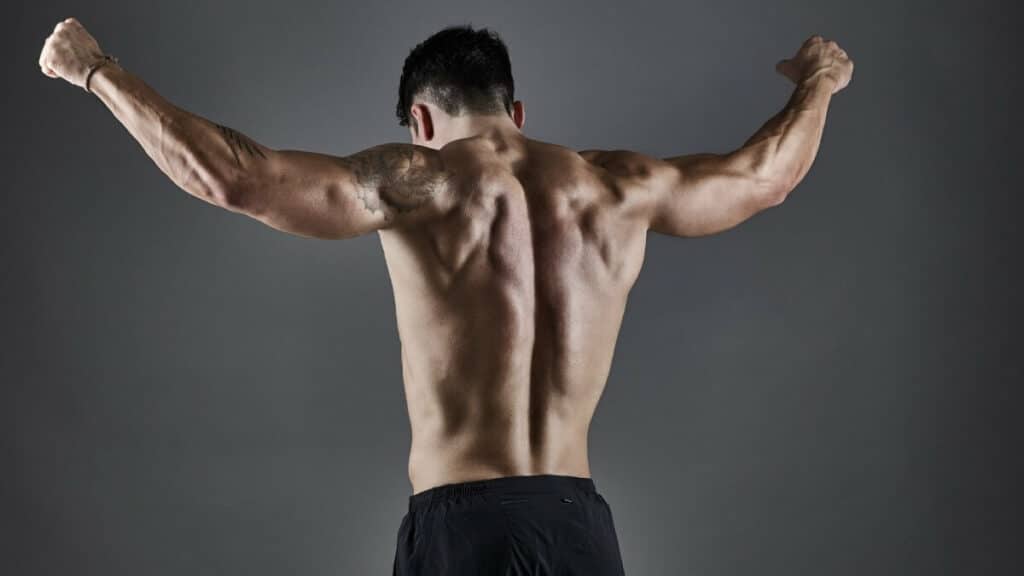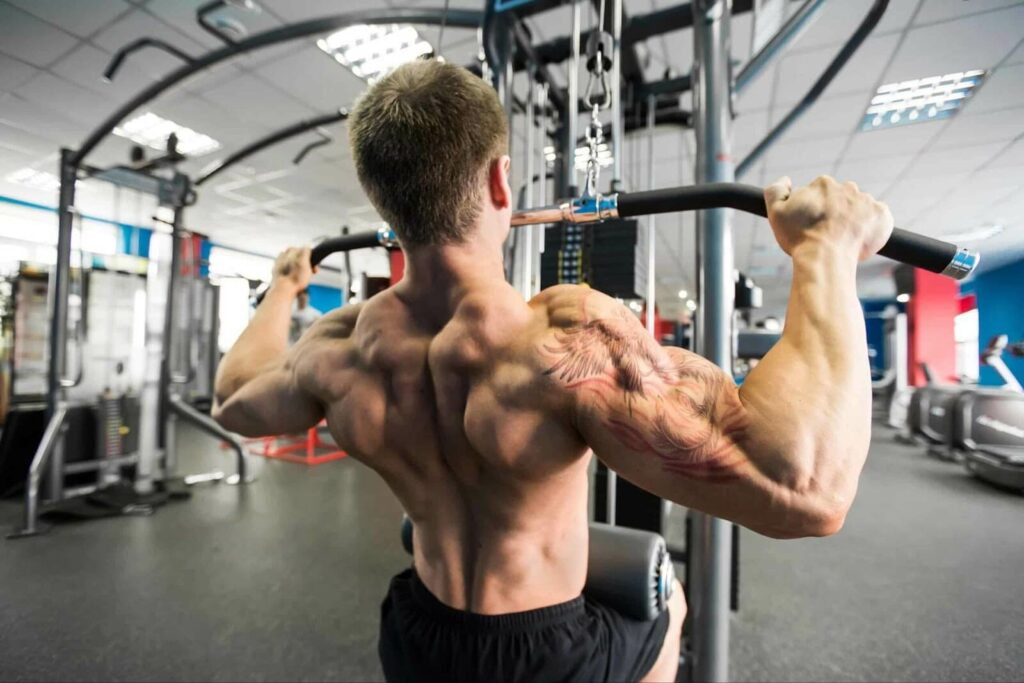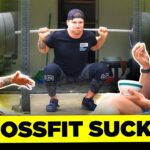One of the main goals for most people working out at the gym is to have a wide back and rounded biceps to fill up their shirts and show off their toned arms at the beach. It is a reality for both men and women.
A well-developed back and biceps muscles are crucial for boosting anyone’s confidence with their peers. Therefore, we’ve compiled the top 5 back and biceps exercises for a killer pull-day workout. It is a workout that can be done by everyone from advanced athletes to humble beginners.
In this article you’ll learn about the following:
- Back and biceps anatomy & function
- Benefits of training back and biceps together
- Top 5 back and biceps exercises
- Back and Biceps workout
We know that your time is short and valuable, so let’s jump right into it!
Jump to:
Back Anatomy & Function
When we talk about the back muscles, we mainly refer to the latissimus dorsi, commonly known as the “lats.”
The lat (latissimus dorsi) is one of the broadest muscles in the body. It runs horizontally from the spine to the arm bone (humerus), and it’s involved in both thoracic and brachial motion. (1)
Some of the main actions in the upper body are done in conjunction with the teres major and pectoralis major (chest muscle). They adduct, medially rotate, and extend the arm at the shoulder joint. (1)
The lat is more active in climbing, rowing, and pull-ups. However, new research suggests activation during deep inspiration (auxiliary breathing muscle), sneezing, and coughing.
Biceps Anatomy & Function
The biceps are the muscles responsible for flexing the elbow and the supination and pronation of the forearm. Two heads form it:
- Long head (caput longum)
- Short head (caput breve) (2)
Almost every rowing or pulling exercise will target this muscle since the elbow flexion needs to happen to pull the bar toward the chest (concentric portion). Holding the bar with a supinated grip will do the trick if you want to bias biceps recruitment, whereas a pronated grip will focus more on the back muscle groups.
Benefits of Training Back and Biceps Together
Training back and biceps together makes as much sense as training chest and triceps together. Combining primary and secondary movers in a single training session benefits recovery and time-saving.
Good For Recovery
Working them at least twice a week is the most effective way to push your muscles to grow. When you merge both muscle groups (back and biceps) in a single training session, you promote a healthy recovery cushion for them.
Let’s say, for example, you train your back and biceps on Monday; the next time you’d be training them again would be by the end of the week, so you’d have a couple of days in between to give the muscles the necessary rest periods to grow. This is an ideal scenario.
Another scenario would be training back on Monday, then the biceps on Tuesday, then back again on Thursday, and the biceps on Friday. This latter split is not optimal for recovery since you’re constantly stimulating these muscles with barely any rest in between.

Remember that the muscles grow while you rest and eat, not when constantly working out.
Efficient Split
Today’s society is busier and busier. People tend to have less time to pursue anything outside the essentials, so maximizing and optimizing your time at the gym is crucial. Having an efficient split will help tremendously with that.
Training back and biceps together helps with recovery and is proven to be an efficient split because it saves time. Combining both muscle groups on the same training day could reduce the total biceps exercises by 2-3, ultimately saving you time.
If you were to train biceps on a separate day alone, it would take you around 5-6 exercises to complete a session and give those muscle fibers the necessary stimulus they need.
It all boils down to efficiency and making the most out of your time at the gym, especially if you’re someone with little time on their hands and a busy schedule.
Top 5 Back Exercises
When it comes to developing a broad and muscular back, you’re going to need all the help you can get. Therefore, we’ve compiled our top 5 back exercises to help you navigate the noise around them.
These exercises, when done correctly, will skyrocket your muscle growth and give you the results you’re looking for. We recommend mastering the technique with light weights first and then progressively moving to heavier loads for maximum results.
Have fun!
Pull-Ups
Pull-ups are one of the most popular back exercises. It requires a pull-up bar and your arms to drive you up until your chin goes over the bar. Although it seems like a straightforward exercise (which it is), it’s very challenging for almost everyone starting their fitness journey.
Doing your first pull-up is a milestone for many fitness enthusiasts, especially women who reportedly have less upper-body strength than men (3). This is one of the back exercises that will induce the most muscle hypertrophy and muscle growth.
Regardless of your fitness goals, you should include this exercise in your training split to take your upper body muscles to the next level. You can play with underhand, overhand, neutral, close, and wide grip.
Lat Pulldown
The wide-grip lat pulldown is a terrific lat exercise anybody can do. It has a big range of motion, and the starting position has your lats in the stretched position. The cable pulley machine is designed to make lat workouts easy and accessible.
The lat pulldown machine allows a simple movement trajectory. This works phenomenally for lifters because the proper form becomes easier to master, and you’ll feel the constant tension on your lats.
The wide-grip lat pulldown uses a variety of grips which are all effective at recruiting the entire muscle, including the lower fibers of the lat, for example:
– Underhand grip
– Neutral grip
– Overhand grip
According to Snarr et al. (2017) (4), a pronated grip provided significantly greater activation of the LD than a supinated grip.

Barbell Bent Over Row
The bent-over barbell row is the most popular exercise for targeting your lat muscles. The starting position requires your core muscles to step up and stabilize your lumbar spine while your arms drive the bar toward your hip.
This is a terrific row variation for everyone looking to get a lower lat contraction while working on other secondary muscles like rear delts, core, and bicep muscles.
Although this exercise is relatively easy, most beginners could find the starting position challenging for their spine and lower back muscles. Many major muscles are involved in this exercise (compound exercise), so try to avoid heavy weights at the beginning.
You can use a pronated or underhand grip like any other pulling movement. Both are fine and will yield the results you’re looking for.
Chest Supported Row
The chest-supported row is one the safest and most efficient exercises for isolating your latissimus dorsi muscles and increasing muscle mass. It will have you use an incline bench to support your chest, removing the tension from your spine and lower back.
You can use a pair of dumbbells, a loaded barbell, or even kettlebells for this exercise. Before starting the movement, make sure your head, neck, and upper shoulders are off the bench. This will facilitate the range of motion from your arms and shoulder blades.
Start with the weights on the floor and bring them towards your hips while keeping your elbows pointing outward (not touching the bench). As you pull, try to keep your chest and torso from going off the bench. Instead, aim to pin yourself down and your row to increase muscle tension.
Inverted Row
The inverted row is one of the best rowing exercises anybody can do. It’s an excellent option for beginners, intermediate, and advanced lifters. An inverted row is the same as a bodyweight row or an Australian pull-up, as some people call it.
It’s often used as a variation of the bent-over row, which requires more equipment, balance, and attention to technique. This is a terrific exercise to improve your pulling mechanics, posture, hand grip, and core muscles.
The inverted row is simpler and almost intuitive, and you only need a bar and support to make gains. For a proper form, at the starting position, you want to bring your feet together and keep your torso in a straight line with your butt and legs.
Before initiating the movement, your butt should be in the air while holding a contraction, just like your torso and core muscles. Grip the bar (underhand or pronated) outside of your shoulders and pull your chest closer to the bar. Slowly go back to the starting position, and that’s one rep.
Top 5 Biceps Exercises
To complement our top 5 back exercises list, we are giving you our top 5 biceps exercises to pair along with. These exercises will require a pair of dumbbells, loaded barbells, a cable machine, and a bench.
Without further ado, get ready to blast those guns!
Dumbbell Biceps Curl
The dumbbell curl is one of the most popular exercises in the fitness community. It doesn’t matter your age, goals, or fitness level; chances are you’ve done them at some point. To nobody’s surprise, this exercise is highly effective at targeting the biceps brachii (biceps muscle).
With no more than a pair of dumbbells (or even one), you can have yourself a terrific biceps workout routine. Hold the dumbbells to the outer part of your legs with an underhand (supinated) grip.
Flex the elbows until the dumbbells are close to your biceps muscle, and slowly lower them. This will equal one rep. It is a great isolation exercise to start your biceps routine.
A simple way to turn this movement into hammer curls is changing the grip from supinated to neutral (palms facing each other). Your forearms will thank you!
Barbell Biceps Curl
The barbell biceps curl could be considered a progression of the dumbbell biceps curl. Instead of dumbbells, it will have you using a barbell (loaded or not) to execute the movement, making it more challenging.
The barbell curl is a must for any bicep workout. Grip the barbell (preferably supinated) at the outside of your thighs. Stick your chest out and keep your elbows slightly in front of you. Bring the barbell up by flexing at your elbow joint until the barbell almost reaches the biceps and slowly goes down. This will equal one rep.
If you feel any discomfort in your wrist, don’t panic. This is normal for many beginners due to the full supination of your forearms while executing the movement. Use a lighter weight, and don’t push yourself too hard initially.
Cable Biceps Curl
The cable biceps curl requires a cable pulley machine and an attachment with a straight or curved bar. This is another terrific variation to target muscles around the biceps.
It’s considered a constant resistance exercise, allowing constant tension throughout the entire range of motion. Once you’ve picked the bar, use an overhand grip, and from a standing position, begin to flex your elbows as you bring the bar towards your chest.
You’ll soon notice how the muscle contraction differs from the barbell curl and other exercises. Don’t be surprised if your forearm muscles also take a hit after a few reps. Feel free to explore heavier weights with maximum contraction, but be mindful of not overarching your spine during the curling movement.
Alternating DB Biceps Curl
Alternating DB biceps curl is another staple for direct biceps training. It serves as a variation from the standard dumbbell biceps curl. In this modification, you’ll notice how you can use more challenging weights while prioritizing muscle recovery.
Compared to the DB curls, alternating the reps allows for a slight rest, which results in being able to move more weight for longer, which ultimately translates to more muscle gain. Make sure to keep a form strict and limit swinging your arms looking for momentum.
Chest Supported DB Biceps Curl
If you want to isolate your biceps brachii to the maximum, try the chest-supported DB biceps curl. The inclined bench will have your chest supported, removing tension from your back and allowing you to isolate your biceps even more.
This variation craves lighter weights and a slower tempo than other exercises from this list. Since the isolation is more significant, you’ll notice your biceps fatiguing faster, which is crucial for building strength.
For better form, keep your elbows from returning as you bring the dumbbells up. This would remove the tension you’re looking to generate at the biceps.
Back And Biceps Workout
Now that you’re fully equipped with some of the best exercises for back and biceps muscular strength gains, it’s time to put them all together for a killer workout.
As any fitness professional suggests, try to go from low weights to heavier loads (progressive overload), especially if you’re a beginner. This will help you gain muscle control and build all-over muscle mass.
Let’s begin!
- A1) Pull-Up
- A2) Bent-Over Barbell Row
- A3) Lat Pulldown
Perform 3-4 sets of 8-12 reps at heavy weight. Start low and finish close to hitting muscle failure. Rest 90 seconds in between.
- B1) Chest Supported DB Row
- B2) Inverted Row
- B3) Alternating DB Biceps Curl
Perform 2-3 sets of 8-10 reps at a moderate weight. Rest 90 seconds after each set.
- C1) DB Biceps Curl
- C2) Barbell Biceps Curl
- C3) Cable Curls
Perform 1-2 sets of maximum reps (muscle failure). Rest 60 seconds after each set. The goal is to make the most challenging block of the entire day training split.
If you feel like modifying any exercises, please do so, especially if you’re experiencing any pain or discomfort. Safety first!
FAQ’s
Is It Good To Workout Back And Biceps Together?
Yes, it is good to work them both together. Your back workout will secondarily stimulate your biceps, which serves as a warm-up before isolating the biceps entirely. This is considered an efficient way to split your upper body training since it’ll also save you time.
What Workouts Are For Back And Biceps?
Some of the best back workouts are the pull-ups, lat pulldowns, barbell bent-over row, chest-supported row, and the inverted row. A terrific selection for biceps workouts is dumbbell biceps curl, cable biceps curl, barbell biceps curl, alternating dumbbell biceps curl, and chest-supported dumbbell biceps curl.
How Many Bicep Exercises Should I Do On Back And Bicep Day?
This will depend on your fitness level, but 3-5 exercises are usually enough to add the necessary volume to grow your biceps. It’s important to highlight that working your back will secondarily work your biceps, although, at a lesser intensity, you’ll feel your biceps burning before doing the first isolation biceps workout.
Featured image credits : Jeff Nippard














